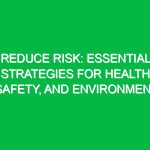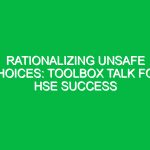Introduction
In the realm of Health, Safety, and Environment (HSE), understanding the respiratory protective equipment definition is paramount. Respiratory protective equipment (RPE) serves as a crucial barrier between workers and hazardous environments, shielding them from inhaling harmful substances such as dust, fumes, vapors, and biological agents. The significance of RPE cannot be overstated, particularly in industries where exposure to airborne contaminants is an everyday risk. This article aims to explore the concept of respiratory protective equipment, its types, regulations, and Best Practices, all while focusing on its critical definition within the HSE framework.
Understanding Respiratory Protective Equipment Definition
At its core, the respiratory protective equipment definition refers to devices designed to protect the wearer from inhaling harmful airborne substances. These can include particulate matter, gases, vapors, and smoke. RPE is vital in various sectors, including construction, healthcare, mining, and manufacturing, where the risk of respiratory Hazards is prevalent. The equipment can range from simple dust masks to complex, powered air-purifying respirators (PAPRs).
Types of Respiratory Protective Equipment
An understanding of the different types of RPE is essential for effective implementation in the workplace. The following is a breakdown of the primary categories:
- Filtering Facepieces (FFP): These are disposable masks that filter out particles from the air. They are classified into three categories (FFP1, FFP2, and FFP3) based on their filtration efficiency.
- Half-Mask Respirators: These cover the nose and mouth and are equipped with filters or cartridges designed to protect against specific contaminants.
- Full-Face Respirators: These provide a complete seal around the face and protect the eyes in addition to the respiratory system. They are used in environments with toxic gases or vapors.
- PAPR: Powered air-purifying respirators use a battery-powered blower to pull air through filters, providing a higher level of protection and comfort for extended wear.
- Self-Contained Breathing Apparatus (SCBA): Typically used in firefighting and rescue operations, SCBA provides breathable air from a tank, allowing users to operate in oxygen-deficient or hazardous environments.
Importance of Respiratory Protective Equipment
The importance of RPE cannot be overstated. Inhalation of harmful substances can lead to severe health repercussions, including respiratory diseases, long-term lung damage, and even death. According to the World Health Organization (WHO), around 4.3 million people die each year from exposure to indoor air pollution, primarily from solid fuels and kerosene used for cooking. This statistic underscores the necessity of proper respiratory protection in both occupational and domestic settings.
A personal anecdote illustrates this point vividly. A friend of mine worked in a factory where he was exposed to dust and chemical vapors daily. Initially, he dismissed the importance of wearing a mask, believing it to be an inconvenience. However, after experiencing persistent coughing and shortness of breath, he sought medical advice, which revealed early signs of occupational asthma. This experience highlights the critical role that RPE plays in safeguarding health and preventing chronic diseases.
Key Components of Respiratory Protective Equipment
Understanding the components of respiratory protective equipment is vital for ensuring its effectiveness. Here are some key elements:
Fit and Seal
A proper fit is essential for RPE to function effectively. If the equipment does not fit well, contaminants can enter through gaps, rendering the protection useless. Fit testing should be conducted to ensure that workers are using the right size and type of respirator. This process involves checking the seal between the respirator and the face to confirm that it is airtight and secure.
Filter Efficiency
Filters are a critical component of many types of RPE. They are classified based on their ability to capture particles or gases. Understanding the type of hazard present in the workplace is essential to selecting the appropriate filter. For example, FFP3 filters have a higher filtration efficiency than FFP1, making them suitable for environments with more hazardous particles.
Comfort and Usability
For workers to consistently wear RPE, it must be comfortable and easy to use. Features such as adjustable straps, lightweight materials, and low breathing resistance can significantly impact compliance. Regular Training on the correct usage and Maintenance of RPE is also crucial to ensure its effectiveness.
Potential Hazards and Safety Considerations
While RPE is designed to protect against respiratory hazards, it is essential to recognize that not all equipment is suitable for every situation. Misuse or improper selection can lead to serious health risks. Here are some considerations:
Inadequate Protection
Using the wrong type of RPE can expose workers to significant risks. For example, using a simple dust mask in an environment where chemical vapors are present can lead to severe inhalation injuries. It’s crucial to conduct a thorough risk assessment to identify the specific hazards and select the appropriate RPE accordingly.
Over-reliance on RPE
Some employees may become overly reliant on RPE, neglecting other Safety Measures such as ventilation or engineering controls. While RPE is vital, it should be part of a comprehensive Safety strategy that includes eliminating or minimizing hazards at the source.
Maintenance and Inspection
Regular maintenance and inspection of RPE are necessary to ensure its effectiveness. Filters can become clogged, and equipment can deteriorate over time. Establishing a routine for checking and replacing RPE is essential for maintaining a safe working environment.
Best Practices for Respiratory Protective Equipment
To maximize the effectiveness of respiratory protective equipment, consider the following Best Practices:
- Conduct Risk Assessments: Regularly assess the workplace for potential respiratory hazards and determine the appropriate RPE needed.
- Implement Fit Testing: Ensure that all workers using respiratory equipment undergo fit testing to guarantee proper seal and fit.
- Provide Training: Offer comprehensive training on the correct usage, maintenance, and limitations of RPE.
- Establish a Maintenance Schedule: Create a routine for inspecting and replacing RPE to ensure that it remains effective.
- Promote a Safety Culture: Encourage workers to prioritize safety and report any issues related to RPE or workplace hazards.
Regulations and Standards Governing Respiratory Protective Equipment
In many countries, regulations govern the use of respiratory protective equipment to ensure worker safety. In the United States, the Occupational Safety and Health Administration (OSHA) provides guidelines that outline the requirements for RPE. Specifically, osha mandates that employers assess respiratory hazards and provide appropriate protection when necessary. Similarly, the European Union has established Regulations under the Personal Protective Equipment (PPE) Directive, which sets standards for the design and performance of RPE.
Compliance with these regulations is not merely a legal obligation; it is a critical aspect of promoting a safe work environment. Failure to adhere to these standards can lead to severe consequences, including fines, legal action, and most importantly, health risks for workers.
Conclusion
In summary, the respiratory protective equipment definition encompasses a wide range of devices designed to protect individuals from inhaling harmful airborne substances. Understanding the types, components, and best practices associated with RPE is essential for ensuring the safety and health of workers. Furthermore, compliance with regulations enhances the overall effectiveness of RPE in the workplace.
As we navigate an increasingly complex world where occupational hazards are ever-present, the significance of RPE remains paramount. It is not just about compliance; it is about safeguarding the lives of individuals who contribute to our economies and societies. By prioritizing respiratory protection, we can foster safer work environments and promote health, safety, and environmental Sustainability for all.


